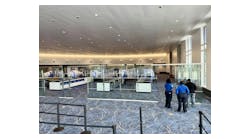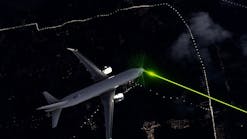In 2011, a major California airport hired a risk management/risk assessment organization to look for weak security points at their facility. The assessment evaluated several high-tech security measures the airport currently had in place and suggested new measures airport administrators could take to beef up protection and reduce potential threats and risks.
Among the recommendations to consider were a new generation of more robust baggage scanners, backscatter x-ray equipment and full-body scanners — all technologies that have played a much more significant role in airport security since 9/11.
There were also some low-tech recommendations. For instance, the risk assessment organization found weak points in the airport’s perimeter. Often airports rely on surveillance beams and cameras to protect their boundaries, but these systems are not always dependable. In this case, there were areas where someone could possibly get onto the airfield, innocently or with malicious or dangerous intent.
As we mentioned, this was a large airport. Change sometimes moves slowly in any large facility, even when it involves security. Indeed, when it came to one security measure recommended, change did come too late.
On April 16, 2014, a 16-year-old boy managed to get on the airfield and stow away on a flight from California to Hawaii, by hiding in the plane's wheel well. Surviving cold temperatures at 38,000 feet and a lack of oxygen, "the kid is lucky to be alive," said FBI spokesman Tom Simon in Honolulu. Noting the boy was unconscious for the lion's share of the flight, "he doesn't even remember the flight."
The airport we are discussing here is San Jose International Airport. The risk management/assessment organization was my company, TAL Global, based in Silicon Valley. Since then, we have gone on to work with airport administrators in all parts of the world, helping them minimize risks, threats, and even unexpected events – including stowaways.
Security Recommendations
While many of the recommendations we provided to airport administrators are specific to their facilities, several can apply to airports worldwide and especially those here at home:
Security Questioning: Security questioning is a technique often associated with Israel's Ben Gurion Airport. It involves asking passengers a series of questions. The answers to these questions are almost irrelevant. Authorities are looking for behaviors and body language that experience indicates could be "red flags."
Security questioning is also used in some American airports, but there, the answers are what agents focus on. Passengers may be asked one or several times, "Did you pack your bags yourself?" or "Have your bags been out of your possession?"
These questions are used as a deterrent but are not necessarily designed to stop a passenger. Their answers are a statement. If, for example, a bomb was found in a passenger's luggage, it would be more difficult for the traveler to avoid a conviction claiming they had no idea how the device got there
Behavioral Pattern Technologies: These technologies are the high-tech version of security questioning. Taking center stage shortly after 9/11, these technologies look for unique behaviors often associated with airport users planning unlawful activity. These systems are designed to fill the gap left by most common security approaches that rely primarily on the detection of banned items but ignore the people who carry them. While some of these systems use different forms of "racial profiling," many airport administrators have decided that when it comes to airport and passenger security, they must place security concerns first.
Randomized Canine Inspections: At a Congressional hearing in July 2011, William Parker, the inspector-commander of the Amtrak Police Department's K9 Unit, said that on Amtrak as well as in airports, "a well-trained dog is more capable, useful, reliable, and effective than [security] equipment. Dogs do not depreciate like machinery. If dogs are trained properly, and their training is consistent, their skill level will increase with experience."
Canines have proven their value in security for years. However, what can impede their benefit to airport security is that canines are often used on set schedules. A sweep is made of one gate at 9 p.m., an entrance at 11 p.m., then another at noon. Canine sweeps need to be randomized. Set schedules are easy to detect and provide easy openings for potential threats.
To further enhance the use of dogs for airport security, some airports are turning to the ARMOR (Assistant for Randomized Monitoring Over Routes) project. Based on algorithms developed after several years of research, "the ARMOR project is focused on developing methods for creating randomized plans for monitoring, inspecting, patrolling and security in general," writes Milind Tambe with Harvard University, and one of the developers of the program. Further, it helps take the "human element" out of security, replacing it with scientifically-based technology.
Biometric Entry/Exit Systems: As a result of an executive order, signed by President Trump in March 2017, by 2021, the top 20 airports in the United States are to screen “100 percent of all international travelers” including American citizens arriving at U.S. airports from overseas. This will be handled primarily by what the U.S. Customs and Border Protection Agency calls biometric entry and exit systems. More commonly, this technology is known as facial recognition.
While used and accepted in airports around the globe, it has stirred up some controversies in the U.S. In some cases, it is not always correct, identifying one face with the wrong person. In other situations, there can be security breaches. Recently, a facial recognition system exposed the personal information of 2.5 million people after a database was left unprotected. However, these technologies are being fine-tuned and as security becomes an ever-greater concern in airports around the world, we can expect they will be used far more frequently in the future.
COVID and Airport Security
We are in an exceedingly difficult situation when it comes to COVID and airport security. In this case, the word “security” takes on the added meaning of protecting the health and safety of airport personnel as well as travelers.
To address this challenge, many airports have installed supplemental hand sanitation stations throughout their facilities, placed decals on floors to encourage social distancing, installed walkway directional signs and where possible, installed plastic barriers. No-touch restroom fixtures are now the norm as are different forms of smart technology that help minimize interactions between airport staff and travelers.
What’s more, new technologies are coming online that can help us quickly detect those that might have the disease and pose a risk to others.
For instance, rapid COVID diagnostic systems that deliver results in 15 to 30 minutes have been developed at the University of Oxford. At Heathrow Airport in London, an entire diagnostic facility has been created to screen passengers bound for certain parts of the world. If the tests prove negative, the passenger can board the flight and may not be required to quarantine themselves upon arrival at their destination.
However, not all these measures, including new rapid diagnostic systems, have proven totally reliable in stopping or significantly reducing the spread of the disease. A study published in September, but conducted earlier in the year, found that with most current airport screening measures in place:
Only a small proportion of cases were detected at airports during entry screening. Entry screening alone cannot be effective to prevent importation of cases but could be considered as a supplementary response measure to information strategies at airports.
The problem, according to these researchers, is that people may travel with “mild symptoms, be asymptomatic, pre-symptomatic, or are concealing symptoms that cannot be detected through entry screening.” However, the researchers concluded that even with its limitations, what systems we have in place should be continued, if for no other reason than to detect those small number of travelers with the disease that are trying to board airplanes.
However, there are other measures airport administrators can take. Among these are the following:
- Installing hand sanitation stations throughout the facility
- Adding floor decals to enforce social distancing along with walkway directional signs
- Implementing crowd control systems and finding ways to ensure adequate physical distancing, especially in those areas that historically get bottlenecked such as at security points
- Installing faster and more effective carry-on baggage screening devices, which speed check-in, minimize congestion, and lower false alarm rates
- Allow for contactless identity checks
- Eliminating as many physical and verbal interactions between airport staff and personnel as possible via advanced biometric systems such as those discussed earlier
- Installing see-thru plastic barriers where staff and passengers must interact
- Increase cleaning protocols. This would include working with cleaning consultants to ensure custodial workers are using cleaning solutions and disinfectants properly as well as using technologies such as electrostatic sprayers safely, correctly and effectively.
And there is one thing more that is recommended due to the pandemic: cooperation. Cooperation and active information sharing among airport administrators is paramount and can help all airports harmonize their safety practices.
Further, pay close attention to publications such as this and others that provide credible, reliable information to airport administrators. This will help improve safety and increase public confidence in air transportation, something that is imperative now and going forward.
Johnathan Tal is CEO of TAL Global. Based in Silicon Valley, TAL Global is a leading risk management, security consulting, and investigative agency serving airports and other clients all over the world. He can be reached through his company website.






